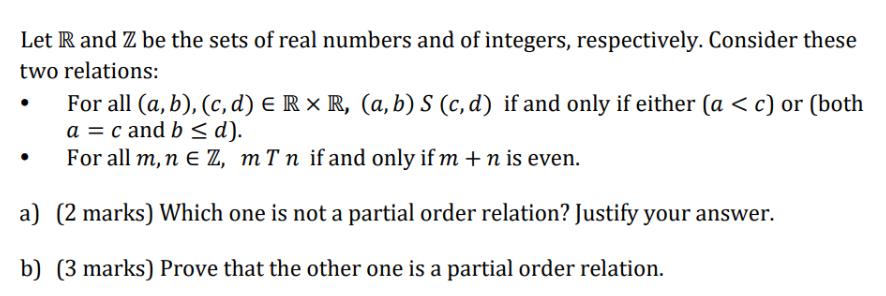Question
Let R and Z be the sets of real numbers and of integers, respectively. Consider these two relations: For all (a, b), (c,d) ERX

Let R and Z be the sets of real numbers and of integers, respectively. Consider these two relations: For all (a, b), (c,d) ERX R, (a, b) S (c,d) if and only if either (a < c) or (both a = cand b d). For all m, n E Z, m T n if and only if m + n is even. a) (2 marks) Which one is not a partial order relation? Justify your answer. b) (3 marks) Prove that the other one is a partial order relation.
Step by Step Solution
3.48 Rating (158 Votes )
There are 3 Steps involved in it
Step: 1

Get Instant Access to Expert-Tailored Solutions
See step-by-step solutions with expert insights and AI powered tools for academic success
Step: 2

Step: 3

Ace Your Homework with AI
Get the answers you need in no time with our AI-driven, step-by-step assistance
Get StartedRecommended Textbook for
Probability And Statistical Inference
Authors: Robert V. Hogg, Elliot Tanis, Dale Zimmerman
9th Edition
321923278, 978-0321923271
Students also viewed these Accounting questions
Question
Answered: 1 week ago
Question
Answered: 1 week ago
Question
Answered: 1 week ago
Question
Answered: 1 week ago
Question
Answered: 1 week ago
Question
Answered: 1 week ago
Question
Answered: 1 week ago
Question
Answered: 1 week ago
Question
Answered: 1 week ago
Question
Answered: 1 week ago
Question
Answered: 1 week ago
Question
Answered: 1 week ago
Question
Answered: 1 week ago
Question
Answered: 1 week ago
Question
Answered: 1 week ago
Question
Answered: 1 week ago
Question
Answered: 1 week ago
Question
Answered: 1 week ago
Question
Answered: 1 week ago
Question
Answered: 1 week ago
Question
Answered: 1 week ago
View Answer in SolutionInn App



